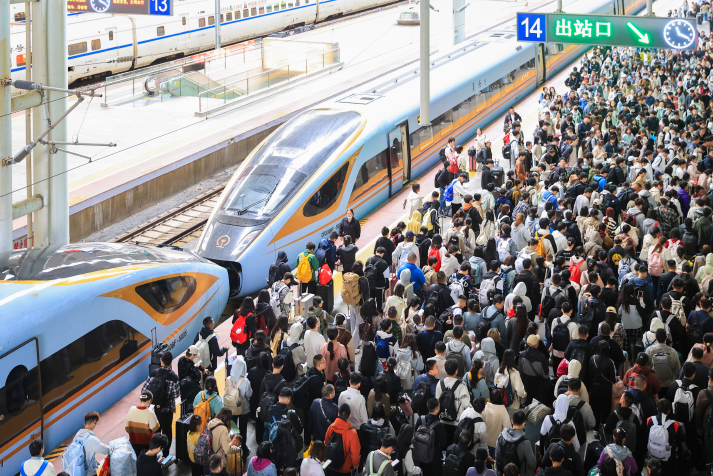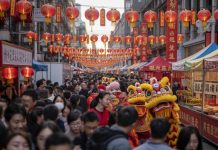In a realm where ethereal melodies blend with graceful dances, celestial beings drift serenely, accompanied by cranes in joyful flight and the elegant fluttering of divine birds. Towering palaces rise in layers, shrouded in mist and adorned with pastel hues, creating a resplendent scene reminiscent of a heavenly realm. This dreamlike paradise, featured in the action game Black Myth: Wukong, is actually inspired by the real-life setting of Qianfo An (literally Temple of One Thousand Buddhas) in Xixian County, Shanxi Province.
Qianfo An derives its name from the large number of Buddha statues housed in its main hall. This ancient temple is renowned as the “museum of suspended sculpture.” Aside from the wooden doors, windows and beams, the walls and columns are adorned with a myriad of clay sculptures depicting diverse figures, beasts and celestial palaces. The sculptures’ intricate craftsmanship creates a stunning scene.
Xixian, with a population of roughly 91,000, saw an influx of 91,700 tourists during the National Day holiday, known domestically as the Golden Week, from October 1 to 7. According to state broadcaster China Central Television, this represented a 335-percent increase compared to the same period last year, driven by the county’s rising fame due to the popularity of the game.
Released on August 19, and selling 10 million copies within three days, Black Myth: Wukong is one of the fastest-selling video games of all time, according to Statista.com. It was developed by Chinese studio Game Science.
The tourism boom has introduced people to the county’s unique historical sites and its local specialty, pears. It has brought direct economic benefits, with remarkable improvements in dining, accommodation and pear sales. The influx of tourists has breathed new life and hope to the local economy, Lu Xuehui, Deputy Mayor of Xixian, said.
What kind of chemistry unfolds when the splendor of golden autumn coincides with a weeklong holiday? Xixian’s tourism boom is just one dazzling piece of China’s holiday economy kaleidoscope—there’s so much more to explore.
According to the Ministry of Culture and Tourism, the seven-day National Day holiday saw 765 million domestic trips nationwide, representing a 10.2-percent increase compared to the same period in 2019. Domestic tourists spent more than 700 billion yuan ($99 billion), 7.9 percent higher than in 2019.
This year, trips to small cities and counties showed an increase in popularity.
According to online travel agency Ly.com, the growth rate of hotel bookings in popular county-level destinations across China outpaced the overall market during the holiday. Nearly 100 counties and county-level cities reported a bookings surge of over 50 percent year on year.
Rich cultural resources are major drawcards of small cities and towns, Han Yuanjun, a researcher at the China Tourism Research Institute, told Beijing Review.
The appeal of avoiding crowds and enjoying high-quality experiences at lower costs is another big factor, he added.
According to online travel agency Qunar.com, high-star hotels in county-level areas proved particularly popular, with bookings soaring 50 percent year on year during the holiday.
According to e-commerce platform for services Meituan, spending by visiting tourists in county-level areas has grown rapidly at a compound annual rate of 29.8 percent from 2019 to 2023. In 2023, spending by tourists from elsewhere accounted for nearly 25 percent of total consumption in these areas.
“People from big cities are eager to explore niche destinations in smaller cities, while those from small towns are keen to travel abroad to broaden their horizons,” Han said, adding this might very well be the future direction of travel.
According to the National Immigration Administration, during this year’s National Day holiday, border control authorities across the country facilitated a total of 13.098 million inbound and outbound travelers, with a daily average of 1.871 million, a 25.8-percent year-on-year increase.
Qunar.com’s National Day Holiday Travel Report stated that this year’s seven-day break saw international flight bookings double compared to last year, with domestic travelers reaching 1,597 cities in 144 countries.
It’s noteworthy that residents of small cities and towns have become new growth drivers of outbound travel, with their outbound travel bookings during the holiday up by 300 percent year on year, data from the platform showed.
The Tourism Authority of Thailand said that from September 30 to October 6, up to 160,000 Chinese tourists visited Thailand, up 33.9 percent month on month.
In addition to travel expenses, the Golden Week also saw a wide range of standout consumption trends.
China announced in March the establishment of a large-scale program to encourage equipment upgrades and consumer goods trade-ins to expand domestic demand, and stepped up policy support in July with an extra funding injection of 300 billion yuan ($43 billion) via ultra-long special treasury bonds.
Encouraged by the trade-in policy and automaker discounts, the holiday saw new car sales increase 11.7
percent—with new-energy vehicle (NEV) sales surging 45.8 percent year on year. Several NEV manufacturers reported over 10,000 cumulative orders during the seven-day period.
NEVs refer to vehicles completely or mainly driven by new energy sources, including battery electric vehicles, plug-in hybrid vehicles, and fuel-cell vehicles.
The home appliance market also experienced a surge in sales. According to e-commerce giant JD.com, its home appliance sales during the holiday increased 67 percent year on year. Similarly, home appliance and electronics retailer Suning.com reported that nationwide store traffic surged over 200 percent, with trade-in orders rising 132 percent compared to the same period last year.
Fueled by the surge in travel and tourism, China’s dining sector buzzed with activity. Data from Meituan showed, from October 1 to 5, the average daily dine-in consumption increased 33.4 percent year on year.
Cinemas were also packed, with box office revenue totaling 2.1 billion yuan ($297 million) during the holiday.
According to value-added tax invoice data from the State Taxation Administration, during the National Day holiday, average daily sales revenue in consumption-related industries increased 25.1 percent year on year. Notably, sales revenue in the snack and fast food sectors grew 8.1 percent and 9 percent, respectively, while camping and homestay revenues surged 43.2 percent and 6.3 percent year on year.
“The booming holiday economy showcases China’s vast market potential and strong economic resilience,” Xu Guangjian, a professor at the Renmin University of China, told Xinhua News Agency.
He said the rapid integration of culture, sports and tourism, combined with innovative business models, is opening up new opportunities for sustained growth and reinforcing the role of consumption as a major growth driver of the economy. –The Daily Mail-Beijing Review news exchange item






